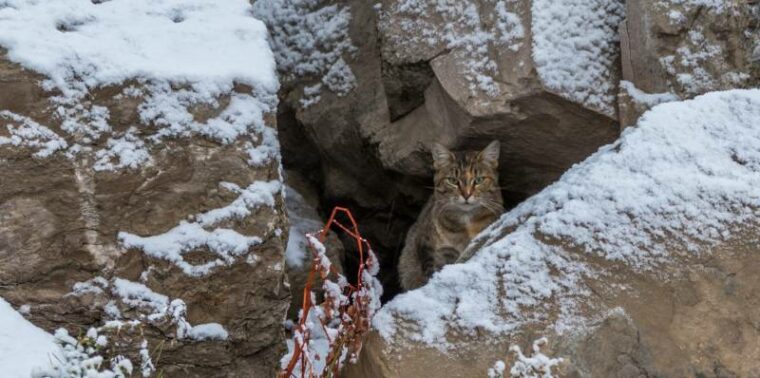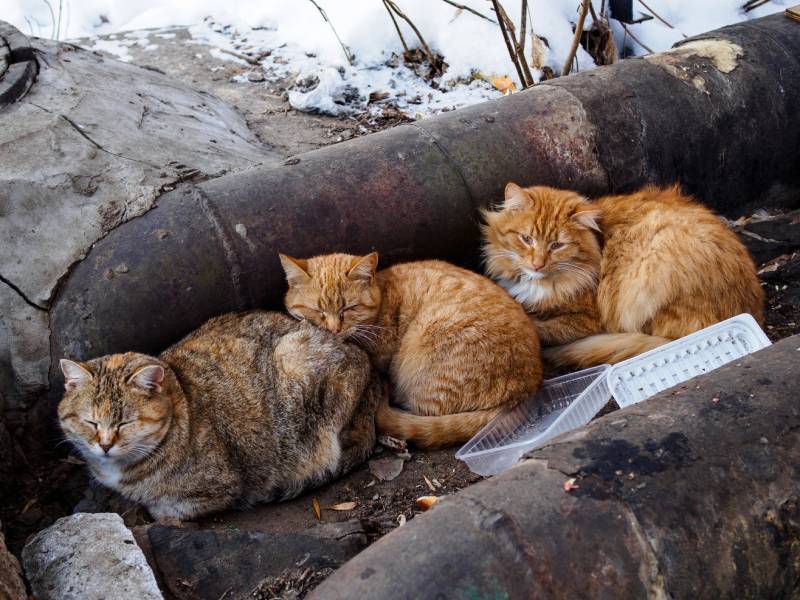
Winter can be a harsh and challenging season for everyone, including stray and feral cats. These cats often live outdoors without a permanent home or caregiver. As a result, they face numerous dangers and obstacles during the colder months.
Despite the challenges, many stray and feral cats can survive and even thrive during winter. That’s only thanks to their physical adaptations, ability to hunt for food, and keen eye for natural shelter. Still, the help of caring individuals and organizations goes a long way in helping stray and feral cats survive the winter.
Keep reading to learn more about how these cats thrive in such conditions and what you can do to make it easier.
How Do Stray and Feral Cats Survive Winter?
Stray and feral cats face many challenges during winter. That includes finding food, water, shelter, and protection from the elements. However, they have developed various survival techniques to cope with these challenges.

Physical Adaptations
Stray cats have adapted physically to help them survive the harsh winter conditions.
Finding Food
Finding food can be a challenge for stray cats during winter. In these months, prey is less abundant, and weather conditions are harsh. However, stray cats have developed several strategies to find food even in these challenging conditions.

Shelter and Protection
Finding shelter and protection from harsh winter weather is essential for the survival of stray and feral cats.
Dangers Faced by Stray and Feral Cats in the Winter
Stray and feral cats face numerous dangers and risks during the winter months. These cats often fend for themselves in harsh conditions without access to food, shelter, or medical care.

How to Help Stray Cats in the Winter
Helping stray and feral cats in the winter requires compassion, awareness, and action. Providing food, water, shelter, and support can improve these animals’ lives and help them survive in challenging outdoor conditions.
Provide Food and Water
Providing food and water is crucial in helping stray and feral cats survive the winter. During the winter, it can be difficult for cats to find enough food and water. Their usual sources may be scarce or frozen.
When setting out food and water, it’s important to place them in a sheltered area to protect them from freezing temperatures. You may place them on a covered porch or garage. Providing shelter for the food and water bowls can also help to keep the cats safe from predators.
In addition, it’s essential to use plastic bowls instead of metal bowls for water and food. That’s because metal bowls can quickly freeze in cold temperatures, along with the food. Furthermore, if a cat tries to eat from a frozen metal bowl, its tongue can become stuck to the ice.

Provide Shelter
Providing shelter is another important way to help stray and feral cats survive the winter. Of course, the shelter provides a warm and dry place for cats to rest. But it also helps to protect them from the elements, predators, and other outdoor dangers.
The shelter should be placed in a protected area, away from wind and snow, and raised above the ground to prevent moisture from seeping in. The shelter should also be insulated with straw or blankets to prevent heat loss. Regularly check the shelter for cleanliness and repair any damage or wear and tear as needed.
Practice TNR
Trap-neuter-return (TNR) is a humane and effective way to help control the population of stray and feral cats. These programs work by trapping cats and having them spayed or neutered by a veterinarian. Then, they return them to their outdoor homes.
This approach helps to reduce the cat population and improve their overall health and well-being. TNR programs help to prevent unwanted litters and reduce the risk of certain health problems. That includes reproductive cancers and infections.
TNR programs also reduce the likelihood of outdoor cats engaging in nuisance behaviors, such as spraying or fighting. They are often run by animal rescue organizations or local governments. Additionally, volunteers help transport cats for spaying and neutering.

Spread Awareness
Spreading awareness is important in helping stray and feral cats survive the winter. Many people may not be aware of outdoor cats’ challenges during winter, or they may not know how to help.
You can do this by sharing information on social media, creating flyers or posters, or speaking to your friends and neighbors about the issue. Highlight the challenges that stray and feral cats face during the winter. That includes a lack of food, water, and shelter and the importance of human intervention.
Donate to a Local Animal Shelter
Volunteering for a local animal shelter is another way to help feral and stray cats in the winter. Many animal shelters provide services and support to stray and feral cats. That includes TNR programs, food and shelter, and medical care.
Many shelters rely on volunteers to trap and transport cats to and from the veterinarian. You can also help feed and care for cats in the shelter or outdoor colonies.
Donating money or supplies is another way to support your local animal shelter. Many shelters rely on donations to provide stray and feral cats with food, shelter, and medical care. You can donate money or supplies such as cat food, blankets, and outdoor cat shelters.
Conclusion
Winter can be a difficult and dangerous season for stray and feral cats. With the right care and support, these cats can survive or even thrive in such conditions. By providing food, water, shelter, and medical care, we can help ensure that stray and feral cats stay warm, healthy, and safe during the colder months.
Featured Image Credit: Glenn Bennett, Shutterstock






